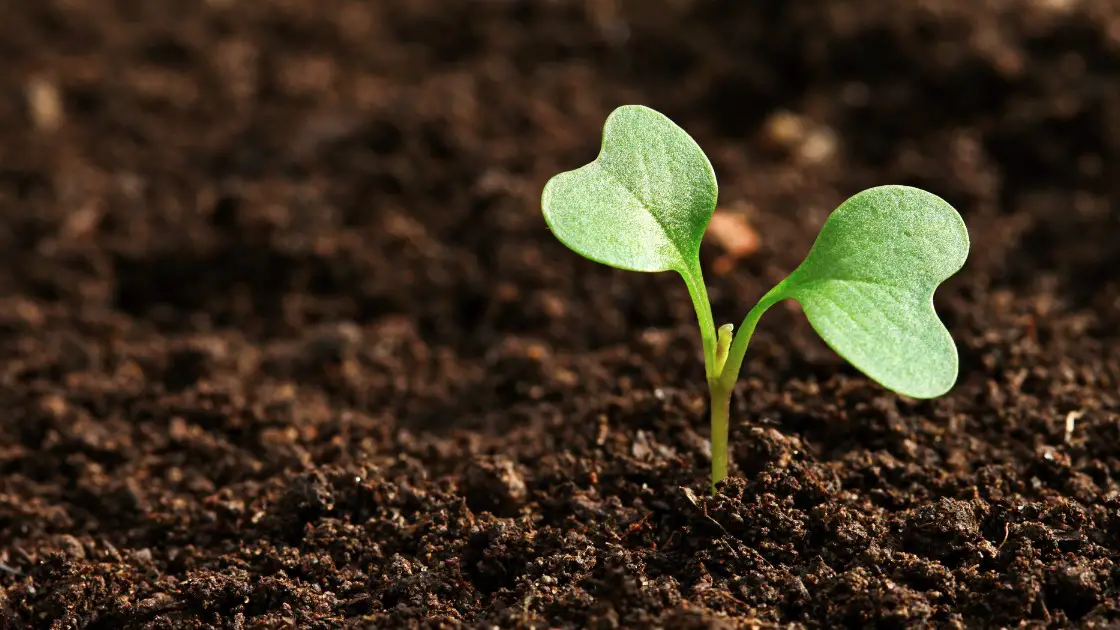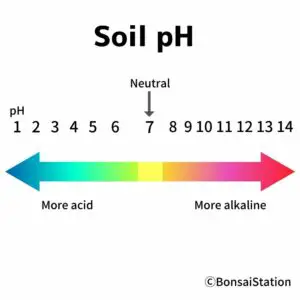Bonsai soil essentials
What is “good” bonsai soil?
Bonsai cultivation relies heavily on the quality of the soil in which the trees grow. Unlike traditional gardening, bonsai trees require a specialized soil mix tailored to their unique needs.
Good bonsai soil must meet the following requirements.
- Good water retention,
- Good drainage,
- Good aeration,
- Adequate soil pH (slightly acidic), and
- Low in nutrients.
Good water retention

During photosynthesis, plants use sunlight as well as carbon dioxide from air and hydrogen from water absorbed through the roots to create their energy source, glucose (sugar). This means they need a constant supply of water to generate energy.
Soil with good water retention enables bonsai trees to absorb water necessary in the process of photosynthesis.
Good drainage/aeration
Bonsai soil needs good water/air entry and exchange for the roots. Plants need water to create energy but the roots need oxygen to burn carbohydrates for the roots’ energy to grow and repair. During this respiration, plant roots use glucose made by photosynthesis for their various functions, like nutrient uptake and maintaining and growing their tissues.
If the soil is always moist and wet, the roots cannot respirate appropriately and will drown in water.
Adequate soil pH (slightly acidic)
What is soil pH?
Soil pH (“potential of Hydrogen”) is a measure of how acidic or alkalic a soil is. The pH scale varies between 0 and 14, in which
- a pH value of less than 7.0 is acid
- a pH value greater than 7.0 is alkaline, and
- a pH of 7.0 is neutral.
When the scale is closer to zero, the soil is highly acidic, and when the scale is closer to 14, the soil is highly alkalic.
pH and bonsai tree growth
Soil pH influences nutrient uptake and tree growth. Many nutrients change their form in reactions to other chemicals in the soil, which are largely controlled by soil pH. Trees may or may not be able to use nutrients when they change form.
Most plant nutrients are optimally available to plants in general within 6.5 to 7.5 pH range, which is generally compatible with root growth as well. For the majority of bonsai tree species, soils with a pH between 5.5 to 6.5, meaning slightly acidic soil, generally provide the best growing conditions.
That said, the vast majority of bonsai tree species can live in a broad soil pH range if the proper balance of required nutrients is maintained.
Low nutrients
Bonsai soil must contain little or no organic matter but should be able to hold the nutrients well when we fertilize it.
If the bonsai soil is rich in nutrients, controling the strength of tree growth becomes harder since the trees grow vigorously using abundant energy in the soil. Branches and internodes tend to elongate when trees grow fast with rich nutrient soil.
It is very difficult (or almost impossible, I should say) to make a bonsai tree grow new branches in between elongated internodes in a natural way once they are grown. You have to cut off the whole branch or major part of it hoping new buds will come out where you want. It may or may not happen depending on the species as well as the tree itself.
Bonsai trees aim to mimic a natural landscape created with plants in a bonsai pot, and elongated branches and internodes prohibit that. So, managing the growth by cutting the nutrients in the soil should be a priority rather than making nutrients always available in the soil for the trees to take in.
Components of good bonsai soil
Creating a good bonsai soil mix involves a delicate balance of components. The following soils are the backbone of bonsai soil, providing the perfect characteristics for bonsai soil mix to attain good water retention, drainage, aeration, adequate soil pH (slightly acidic), and good nutrient-holding capacity.
-
- Akadama or lava rock,
- Pumice, and
- Organic matter/compost.
You can also use vermiculite in a homemade bonsai soil mix.
Akadama or lava rock
Akadama
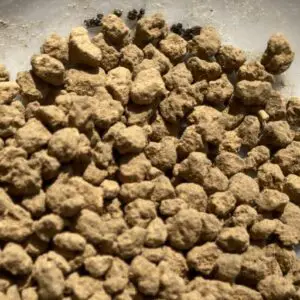
Akadama
Akadama is a volcanic ash from Japan known for its ability to retain moisture while still allowing for adequate drainage and aeration. It is slightly acidic (pH of 5.1-5.5) and can hold onto nutrients very well, which makes Akadama a perfect ingredient for bonsai soil.
Lava rock

Volcanic soil
Akadama is quite expensive and could be difficult to get depending on where you live. In that case, lava rock (volcanic soil) is a good alternative for Akadama.
Lava rocks are formed from lava erupted from a volcano, which, in general, has good aeration and drainage. But its water-holding and nutrient-holding capacities depend on where it comes from.
Pumice

Pumice is a lightweight volcanic rock that contributes to both aeration and drainage. For downside, pumice has low water-holding and nutrient-holding capacity, which is a major drawback as bonsai soil.
Organic matter/compost
Organic matter like composted pine bark or humus retains moisture while having adequate drainage. It gives a constant supply of nutrients, especially for flowering and fruiting bonsai trees which need a high level of plant food for blooming and fruiting.
But in general, bonsai soil should not contain a high percentage of organic matter.
Other soils you can use
You can also use vermiculite in a homemade bonsai soil mix.
For more information on these types of soil you can use for bonsai, please read the following post.
Particle size matters
Why particle size matter?
One of the critical aspects of bonsai soil is the particle size of its components. Different tree species in different conditions have varying root structures and moisture requirements, which means you need to select the right particle size for your bonsai mix.
Root structures
The particle size in the soil mix directly influences how roots interact with the soil.
Different tree species have distinct root systems. Some may develop fine, delicate roots, while others produce thicker, more robust ones. Larger-sized trees generally have thicker roots compared to smaller-sized trees.
Fine root system requires smaller grain size while robust ones need larger grain size.
Moisture requirements
The particle size affects how well the soil retains or drains water in the pot. Stratifying the soil mix with different particle sizes in layers allows for both moisture retention at the top and excellent drainage at the bottom to protect against overwatering.
Also, different tree species have varying moisture needs. Pine trees, for instance, prefer drier soil, while others like wisteria thrive in moist conditions. The particle size affects how well the soil retains or drains water, directly impacting the moisture levels around the roots.
Stability and anchoring
The size and weight of the particles in the soil mix influence the stability of the tree within the pot. Larger particles can provide more stability for larger or top-heavy bonsai trees.
Guideline on the particle size
Here’s a general guideline on the particle size based on the tree size.
| Bonsai size | Particle size |
| Large (<24 in/ 60cm) | 1/8″ – 1/4″ in (3-6 mm) |
| Medium (8-24in/ 20-60cm) | 1/16″ – 1/8″ in (2-3 mm) |
| Small (>8 in/ 20cm) | 1/16″ in (1-2 mm) |
| Mini | 1mm |
Large bonsai trees
Larger bonsai trees have more extensive root systems and require a coarser mix that allows for excellent drainage and aeration.
Medium-sized bonsai trees
Medium-sized bonsai trees can benefit from a balanced mix that provides good drainage and aeration while still retaining moisture.
Small bonsai trees
The tiny bonsai trees have fine root systems that require a finer mix to provide adequate moisture retention and prevent the soil from drying out too quickly.
pH considerations
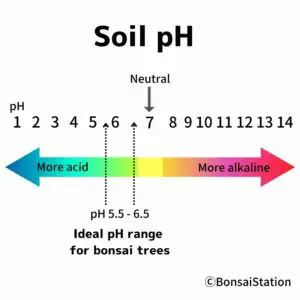
Soil pH & bonsai tree
The pH level of your bonsai soil is another crucial factor to consider. Most bonsai trees thrive in slightly acidic soils, with a pH range of 5.5 to 6.5.
Testing and adjusting the pH of your soil mix may be necessary to ensure it falls within this optimal range. Soil pH kits and additives are readily available to help you achieve the desired pH level.
Ideal pH for each of the bonsai species
While the majority of bonsai tree species prefer slightly acidic soil, the optimum soil pH level differs slightly from species to species.
Here are some of the pH levels they prefer.
Coniferous trees
| Species | pH level |
| Cypress | 5.0-6.0 |
| Hinoki cypress | 5.0-6.0 |
| Japanese cedar | 5.5-6.5 |
| Oak | 5.0-7.0 |
| Pines | 4.5-5.0 |
Deciduous trees
| Species | pH level |
| Beech | 5.0-6.5 |
| Elm | 5.0-7.0 |
| Japanese maple | 5.0-7.0 |
Flower/fruit trees
| Species | pH level |
| Azalea | 4.5-5.0 |
| Camellia | 5.0-5.5 |
| Cherry blossom | 5.0-6.5 |
| Flowering apricot | 5.5-6.5 |
| Magnolia | 5.0-6.0 |
| Rose | 5.5-7.0 |
| Wisteria | 6.5-7.0 |
What is the best brand for Akadama?
(This product is medium-sized grain)
There are a few known brands in the market but Double-Red Line Ibaraki Akadama is the best brand I would recommend for bonsai use. Here’s why.
Reputation
Double-Red Line Ibaraki Akadama is an original brand from a company called Nagahama Corp. and has a solid reputation among bonsai enthusiasts all over the world for providing high-quality soil perfect for bonsai use.
Quality
Double-Red Line Ibaraki Akadama is known for its hardness and resistance to degradation.
Akadama’s quality depends on where it is mined and lower-quality Akadama can degrade pretty quickly (like within a year) with irrigation and freezing/thawing during winter.
Ibaraki region is known for producing particularly high-quality Akadama. For the Doule-Red Line brand, Akadama mined in the region has been sifted and screened to choose only the highest-quality particles, ensuring the best consistency for bonsai.
Is potting mix or any soil OK for bonsai?
Using regular potting mix or any other soil for bonsai is generally not recommended because these soils are not well-suited to the unique requirements of bonsai trees. Bonsai cultivation demands specific soil characteristics, especially the balance between water retention, drainage and aeration, to ensure the health and sound growth of the trees.
Here’s why any soil not specifically mixed for bonsai is generally not suitable for bonsai.
Water retention, drainage and aeration
Bonsai trees require excellent drainage and aeration as well as moisture to produce energy and prevent root rot and provide oxygen to the roots.
Regular potting mixes and garden soils tend to retain moisture for an extended period of time, leading to waterlogged conditions that can harm bonsai roots.
Nutrient content
Bonsai soil mixes are designed to be low in nutrients to control tree growth. Trees receive their nutrients primarily through carefully controlled fertilization.
Garden soils and potting mixes generally have higher nutrient levels that can lead to excessive growth or imbalance in your bonsai shape.
Particle size
Bonsai soil mixtures consist of carefully selected particle sizes to balance water retention and drainage. Potting mixes often have inconsistent particle sizes and may lack the necessary coarser components required for the healthy growth of bonsai roots.
What you need for making bonsai soil
Tools and materials
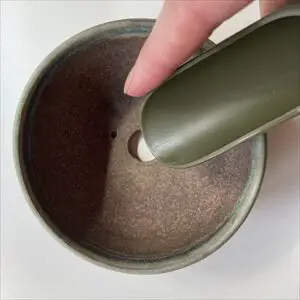
Soil scoop

Soil sieve
To make bonsai soil mix at home, you need;
- Soil scoop or cup,
- Screen or soil sieve with 3 screen mesh sizes (large, medium and small), and
- A few containers to mix and store mixed soil.
Ingredients
Akadama or lava rock
Akadama
Lava rock
Hoffman Lava Rock
As mentioned earlier, select the appropriate particle size based on your tree’s needs and availability. Or you can use a soil sieve to sort the soil components and tailor particle size to your needs.
Pumice
Obtain pumice with the desired particle size, which complements the Akadama or lava rock in your mix.
Organic matter
Espoma Organic Land and Sea Gourmet Compost
Organic matter such as composted pine bark or leaf mold can enhance water retention and provide nutrients.
DIY bonsai soil mix: A step-by-step guide
Now that you’ve gathered all the necessary ingredients, it’s time to create a well-balanced bonsai soil mix tailored to your tree’s specific needs. Follow these steps to achieve the perfect blend.
Step 1: Shift and screen
Before mixing the soil, use soil sieves to separate out the different particles by their relative size and put each size in different containers. This will also remove any fine particles and dust you don’t need.
Why to remove silt/dust?
It is important to get rid of silt/dust (particles less than 0.04 in/ 1mm in diameter) from the soil before you prepare your bonsai soil mix.
If the soil contains fine particles like silt, the soil becomes muddy when water is given, and hardens when dried. This kind of soil has very little room to contain air and does not allow water to pass through. The roots cannot breathe and drown in water.
How to get rid of silt using soil sieve
To get rid of silt/dust,
-
- Place the soil into sieve #1 (the largest mesh). Shake soil over sieve #2 (medium mesh) for a few minutes so that sieve #2 collects smaller soil particles.
- Put the soil collected from sieve #1 (the largest mesh) in a container.
- Shake the soil collected in sieve #2 (medium mesh) into sieve #3 (the smallest mesh) for a few minutes.
- Put the soil collected from sieve #2 (medium mesh) in a container.
- Shake the soil collected in sieve #3 (the smallest mesh) for a few minutes to get rid of silt. You can throw away the silt.
- Put the soil collected from sieve #3 (the smallest mesh) in a container.
- Repeat the process for each type of soil you will use in the bonsai soil mix and put them into different containers.
Step 2: Prepare a container
Prepare a clean bucket or container box. If it is used before, wash it thoroughly to get rid of any mold or bacteria that may cause infestation.
Step 3: Measure your components
Check the ratio of soil you need to mix for your bonsai trees (to be discussed in the next section). Measure the required quantities of each soil. The soil mix ratio should be altered according to the climate you live in and the environment where you place your bonsai trees.
Make sure to use an appropriate particle size. It may save you time if you prepare a bit more than needed. Remember, you can put more soil in the bonsai pot when you water it.
Step 4: Mix thoroughly
Combine all soil in a clean container or bucket. Use your hands or a shovel to mix the components thoroughly. It’s essential to achieve a uniform distribution of particle sizes throughout the mix.
Customizing your bonsai soil mix
While a well-balanced bonsai soil mix serves as an excellent foundation, there are situations where customization becomes necessary depending on the following factors.
- Species
- Climate
- City or countryside
- Bonsai tree placement
- Age of bonsai trees
Soil mix ratio by bonsai tree species
Here’s the general guideline of soil mix ratio for bonsai trees by species under moderate climate. Flowering and fruit bonsai trees need basic nutrients in the soil (organic matter) to bloom and bear fruits.
Basic soil mix by species
| Coniferous | Deciduous | Flower/fruit | |
| Akadama/ Lava rock |
60% | 70% | 60% |
| Pumice | 40% | 20% | 20% |
| Organic compost |
– | 10% | 20% |
Why no organic matter for coniferous trees
Coniferous trees do not require much moisture in the soil. Organic matter tends to retain moisture, which can be problematic for coniferous bonsai that thrive in well-draining soil.
Coniferous trees planted in a high drainage soil without organic matter are able to grow thicker roots, which leads to thicker trunks and branches. Lesser water also results in a rough, coarse bark pattern, which is a good bonsai aesthetic for coniferous trees.
Coniferous trees also do not require nutrient-rich soil. They may not tolerate the release of nutrients at a rate governed by organic matter breakdown.
Climate

Climate plays a significant role in customizing bonsai soil mix for your trees.
Dry climates
If you live in a dry climate like California whose climate is warm and dry year-round, trees may benefit from increased moisture retention. You might want to use less pumice and add more Akadama or organic matter to help the soil retain water.
Humid climates
In areas with high humidity, focus on enhancing drainage. Increase the proportion of pumice and lava rock for drainage and to prevent waterlogged roots.
City or countryside
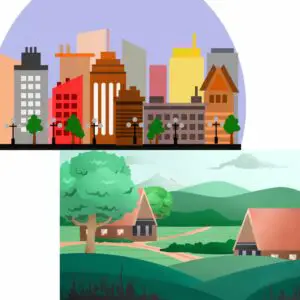
If you live in the city where most of the ground is covered with houses and concrete, the humidity rate is likely to be much lower than in the countryside even though they are in the same region under the same climate.
I’ve moved to a rural area several years ago from a big city, where my house is surrounded by small mountains. What I’ve noticed is that the humidity here is considerably higher than in the city.
As a result, the standard bonsai soil mix tends to retain more moisture than my bonsai trees actually require, especially during rainy and/or cloudy days. Last year, there was a situation when the bonsai soil didn’t dry out adequately, leading to root rot issues with my bonsai trees.
Bonsai tree placement

You might also have to consider where you place your bonsai trees. The more sunlight and wind the trees get, the more dry the soil will be.
The soil mix has to be altered depending on whether you place your trees outdoors under the sun or indoors with less sunlight. Think about how much sunlight and airflow your bonsai trees get during the day and how dry the soil would be.
Age of the bonsai trees
Younger trees need more nutrients and water to grow than older ones and they are less resistant to water shortages. On the other hand, older trees need more drainage in the soil because they absorb less water to create energy.
—–
Reference
Dr. Thomas L. Jensen, SOIL pH AND THE AVAILABILITY OF PLANT NUTRIENTS, IPNI Canada, 2010.

